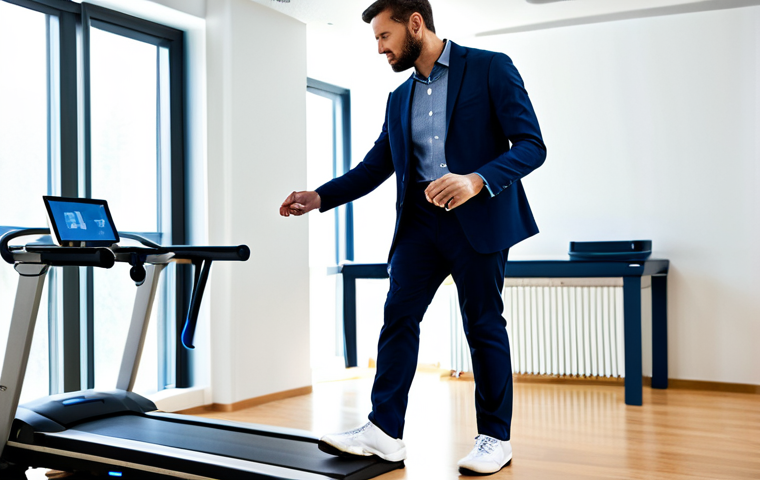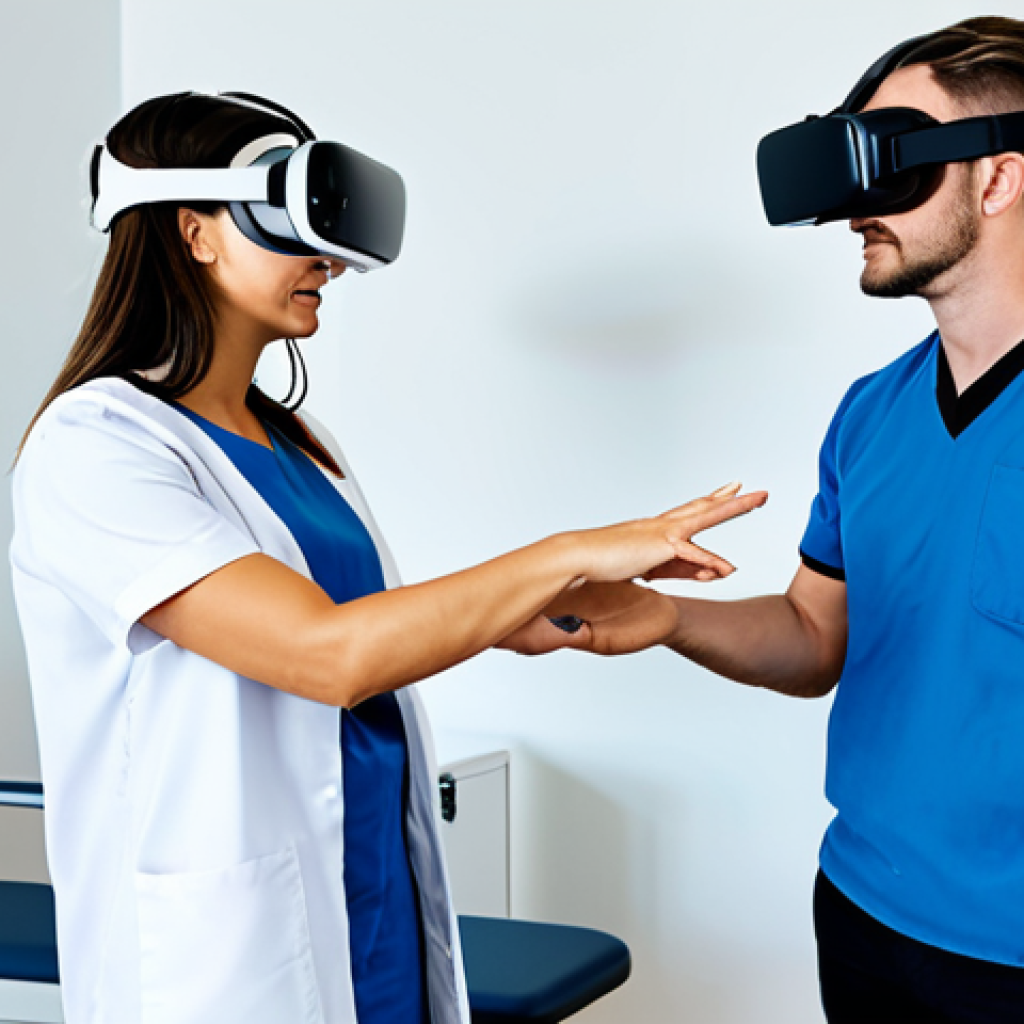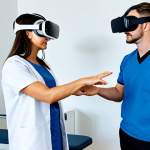Have you ever stepped back and truly considered how rapidly the field of occupational therapy is evolving? As someone deeply immersed in this world, I’ve personally witnessed a seismic shift in how we approach rehabilitation, moving far beyond traditional methods.
It’s a truly exhilarating time, almost like being at the forefront of a medical revolution where technology and neuroscience are converging to redefine patient recovery.
We’re talking about everything from immersive virtual reality systems that make therapy feel like a game, to AI-driven analytics predicting patient progress with astonishing accuracy.
The focus isn’t just on physical recovery anymore; it’s about holistic well-being, leveraging insights from brain-computer interfaces and wearable sensors to craft hyper-personalized intervention plans.
The questions we’re asking – and the answers emerging from cutting-edge research – are challenging our very understanding of human potential and adaptation.
This isn’t just theoretical; it’s directly impacting the lives of individuals struggling with disability and injury, offering them renewed hope and functional independence.
It’s truly a game-changer for our profession. Let’s explore in detail below.
Embracing Digital Therapeutics: The Virtual Revolution

I vividly remember the early days of therapy, where exercises often felt repetitive and, frankly, a little dull for patients. Fast forward to today, and I’ve seen firsthand how virtual reality (VR) and augmented reality (AR) are completely transforming this landscape, making rehabilitation not just effective but genuinely engaging.
It’s a massive leap forward. Imagine a stroke survivor regaining fine motor skills by virtually preparing a meal in a detailed kitchen environment, or a child with sensory processing challenges navigating an immersive, calming digital forest.
This isn’t just about making therapy fun; it’s about creating highly motivating, customizable environments that provide instant feedback, track progress with incredible precision, and allow for endless, safe repetitions of movements or cognitive tasks that would be impossible in a traditional clinical setting.
What truly excites me is how these tools trick the brain into thinking the experience is real, enhancing neuroplasticity and making the therapeutic process more efficient and less like a chore.
The sense of accomplishment patients feel when they master a virtual challenge is palpable, and it translates directly into real-world functional improvements, which is the ultimate goal for any occupational therapist.
1. Immersive VR for Motor Skill Recovery and Cognitive Rehabilitation
My colleagues and I have been exploring how VR offers an unparalleled level of immersion that simply can’t be replicated with standard methods. For instance, I recently worked with a patient recovering from a traumatic brain injury who struggled with executive functions – planning, problem-solving, and attention.
Instead of traditional tabletop exercises, we used a VR program where she had to navigate a bustling virtual marketplace, remember items on a shopping list, manage virtual currency, and avoid distractions.
The real-time cognitive load and environmental demands were perfectly scaled to her abilities, and we could adjust parameters on the fly. I saw her confidence grow with each session, and the carryover into her daily life was astounding.
She even told me, “It didn’t feel like therapy; it felt like I was actually shopping again, and I loved it!” This kind of patient-driven engagement is invaluable.
Similarly, for motor skill recovery, VR allows for highly specific, repetitive movements in a way that feels like playing a game. Imagine a gamified experience where a patient has to reach for virtual objects, improving their range of motion and coordination without even realizing they’re doing therapy.
The data gathered from these sessions also provides us with rich insights into progress and areas needing more attention.
2. Augmented Reality for Real-World Skill Transfer
While VR creates entirely new worlds, augmented reality (AR) overlays digital information onto the real world, and this is where I see immense potential for practical, real-life skill transfer.
Think about it: a patient learning to safely navigate their home after a hip replacement could use an AR app that highlights potential trip hazards or provides visual cues for proper body mechanics as they walk around their actual living room.
Or, for someone working on visual perception skills, an AR overlay could highlight specific objects in their environment to train their attention. I’ve personally experimented with an AR application that guides individuals through complex sequences, like assembling furniture or preparing a recipe, by projecting step-by-step instructions directly onto the physical objects.
This bridges the gap between simulated practice and real-world application, offering immediate, contextual support. The feedback I’ve received from patients is that it feels incredibly empowering, allowing them to practice skills in their own environment, reducing anxiety about making mistakes, and building confidence before they have to perform tasks independently.
It’s like having a personalized, intelligent coach right there with them, guiding them through every step of their recovery journey in their actual home.
The Rise of AI and Big Data in Personalized Care
The sheer volume of data we can now collect on a patient’s journey is staggering, and it’s something that, just a decade ago, felt like science fiction.
Now, with artificial intelligence (AI) and big data analytics, we’re not just collecting data; we’re making sense of it in ways that are revolutionizing how we personalize treatment plans.
As an OT, my goal has always been to tailor interventions, but AI takes this to an unprecedented level. It’s like having an incredibly intelligent assistant that can analyze patterns in recovery, predict potential roadblocks, and even suggest the most effective therapeutic strategies based on millions of data points from similar cases.
This isn’t about replacing the human element; it’s about empowering us to make more informed, evidence-based decisions faster and more accurately than ever before.
I’ve found that using these tools allows me to spend less time on administrative tasks and more time engaging directly with my patients, focusing on the nuances of their individual progress and emotional well-being.
It’s truly elevating our clinical practice from intuitive art to a highly precise science, all while maintaining that crucial human connection.
1. Predictive Analytics for Tailored Rehabilitation Pathways
One of the most exciting advancements I’ve witnessed is the use of predictive analytics. Imagine an AI algorithm sifting through vast amounts of anonymized patient data—demographics, medical history, initial assessments, progress markers, and even adherence to home exercise programs—to identify factors that lead to faster, more sustainable recovery for specific conditions.
This isn’t magic; it’s sophisticated pattern recognition. For example, if an AI can predict that a certain type of exercise, combined with a particular frequency and duration, yields optimal outcomes for a patient with a specific type of wrist injury, it allows me to fine-tune my recommendations with unparalleled precision.
I’ve personally used early versions of such systems to anticipate potential plateaus in recovery, allowing me to proactively adjust therapy plans or introduce new modalities before a patient even feels stuck.
This proactive approach significantly reduces the frustration that often comes with rehabilitation and keeps patients motivated. It’s about getting the right intervention to the right person at the right time, minimizing trial and error, and maximizing efficiency.
2. AI-Driven Tools for Objective Assessment and Progress Tracking
Traditionally, many of our assessments relied on subjective observation or standardized tests that could be time-consuming to administer and analyze. Now, AI-driven tools are providing an objective lens.
Wearable sensors, for instance, can collect continuous data on gait, balance, range of motion, and even sleep patterns, feeding this information into AI algorithms that generate highly detailed reports.
I recall a case where a patient was convinced they were walking “normally” after a knee replacement, but the AI-powered gait analysis system revealed subtle asymmetries and compensatory patterns that needed further addressing.
Without that objective data, we might have missed it. These systems can track minute improvements or subtle regressions that the human eye might not catch, providing incontrovertible evidence of progress (or lack thereof).
This data is invaluable for communicating with patients and their families, as well as for justifying treatment to insurance providers. It allows us to show, not just tell, the impact of our interventions, which from my experience, significantly boosts patient trust and adherence to their therapy plan.
Neuroplasticity Unleashed: Brain-Computer Interfaces and Robotics
The human brain is an astonishingly adaptable organ, and modern occupational therapy is increasingly tapping into its capacity for neuroplasticity in truly groundbreaking ways.
What excites me most is the convergence of neuroscience and engineering, particularly with the development of Brain-Computer Interfaces (BCIs) and advanced robotics.
It feels like we’re just scratching the surface of what’s possible. I’ve had the profound privilege of witnessing individuals, who were once told they might never regain movement or speech, achieve astonishing feats through these technologies.
It’s a testament to the brain’s incredible ability to rewire itself. This isn’t just about providing assistive devices; it’s about actively promoting neurological recovery and functional independence by creating direct pathways between thought and action, or by providing high-intensity, precise motor training that therapists simply couldn’t replicate manually.
The emotional impact on patients seeing even a flicker of movement or control return is immeasurable, offering them a renewed sense of hope and agency over their own bodies.
1. Brain-Computer Interfaces (BCIs) for Restoring Function
BCIs are perhaps the most futuristic aspect of this field, yet they are very much a reality in research and emerging clinical applications. These systems allow individuals to control external devices – like a robotic arm, a computer cursor, or even their own paralyzed limbs via functional electrical stimulation – using only their thoughts.
For occupational therapists, this opens up incredible avenues for individuals with severe motor impairments, such as those with spinal cord injuries or ALS.
I’ve read compelling case studies and even seen videos of patients using BCIs to manipulate objects or communicate, bypassing traditional neural pathways that are no longer functional.
The principle here is that by attempting to move, even without physical output, the brain activity is detected by the BCI, which then translates it into a desired action.
This repetitive mental effort, coupled with external feedback, is believed to stimulate neuroplastic changes, potentially leading to some recovery of natural movement over time.
It’s an intensely challenging but profoundly rewarding area to be involved with, pushing the boundaries of what rehabilitation can achieve.
2. Robotic Exoskeletons and Assistive Devices for Intensive Training
Robotics have transitioned from the realm of science fiction into practical clinical tools that are dramatically improving rehabilitation outcomes. Full-body robotic exoskeletons, for instance, allow individuals with significant mobility impairments to stand and walk, providing repetitive, high-intensity gait training that would be impossible without mechanical assistance.
I’ve observed the remarkable progress of patients using these devices; they provide crucial sensory feedback, help maintain proper posture, and facilitate thousands of repetitions of precise movements, which is key for motor learning and neuroplasticity.
Beyond full exoskeletons, there are smaller, highly specialized robotic devices designed for specific joint or limb training – a robotic glove to assist with hand gripping, or a robotic arm that guides precise reaching movements.
These devices offer consistency and measurable data on force, range, and speed, allowing therapists to precisely track progress and adjust training parameters.
The sheer volume of quality repetitions these robots can provide significantly accelerates recovery for many patients, and the increased independence they gain is truly life-changing.
Beyond the Clinic Walls: Wearables and Remote Monitoring
For years, rehabilitation progress was primarily measured during clinic visits, giving us snapshots of a patient’s abilities in a controlled environment.
But what about their daily life? What happens when they’re at home, navigating stairs, preparing meals, or simply going about their routine? This is where wearable technology and remote monitoring have become absolute game-changers, transforming occupational therapy into a continuous, real-time support system.
I’ve found that extending our reach beyond the clinic offers invaluable insights into true functional performance and adherence to home programs. It’s incredibly empowering for patients to know they’re being monitored and supported even when they’re not physically with us, and it provides a deeper, more accurate understanding of their challenges and successes in their natural environment.
This shift to continuous, remote observation allows for more timely interventions and a truly holistic picture of recovery.
1. Continuous Data Collection for Real-World Insights
Modern wearables – from smartwatches to specialized sensors integrated into clothing or shoes – are quietly collecting a wealth of data about a patient’s activity levels, movement patterns, heart rate, sleep quality, and even fall risk.
This continuous stream of real-world data is gold for an occupational therapist. Instead of relying on a patient’s subjective recall of their activity levels over the past week, I can now access objective metrics.
For example, I’ve used data from smart insoles to analyze a patient’s gait symmetry and step count throughout their day, not just during their therapy session.
This provides crucial insights into how they truly move and engage in daily activities, allowing me to identify compensatory patterns or fatigue levels that might not be apparent during a brief clinic visit.
It also helps validate the effectiveness of home exercise programs. If a patient is showing declining activity levels, I can reach out proactively, rather than waiting for their next appointment.
It’s like having a window into their functional world 24/7.
2. Telehealth and Virtual Home Visits for Accessibility
The global pandemic undeniably accelerated the adoption of telehealth, and while it had its challenges, it also proved to be an invaluable tool for occupational therapy, especially when combined with remote monitoring.
For patients in rural areas, those with transportation challenges, or individuals who are homebound, virtual home visits have been revolutionary. I’ve conducted numerous sessions via video call, guiding patients through exercises, assessing their home environment for safety hazards, and even assisting with adaptive equipment recommendations – all from a distance.
When combined with data from wearables, these virtual interactions become incredibly powerful. I can review their activity logs before a call, then observe them performing tasks in their home, and offer immediate, personalized feedback.
This blend of technology has dramatically improved accessibility to quality therapy, ensuring that more people can receive the consistent care they need to achieve their functional goals, regardless of their location or physical limitations.
Holistic Well-being: Integrating Mental Health and Lifestyle Factors
As occupational therapists, we’ve always understood that true rehabilitation extends far beyond just physical mechanics. It’s about helping individuals participate fully in meaningful daily activities, and that inherently includes their mental and emotional well-being, as well as their lifestyle choices.
What I’ve seen evolving rapidly is the deliberate, evidence-based integration of mental health strategies and comprehensive lifestyle interventions directly into our practice.
It’s no longer a side note; it’s a core component. The impact of chronic pain, disability, or injury on a person’s mood, motivation, and social engagement cannot be overstated.
Addressing these aspects concurrently with physical therapy isn’t just beneficial; it’s absolutely essential for sustainable recovery and a genuine return to a fulfilling life.
This holistic approach resonates deeply with me because it recognizes the patient as a whole person, not just a collection of symptoms.
1. Addressing Mental Health in Conjunction with Physical Recovery
It’s a common misconception that physical recovery is separate from mental health, but in my experience, they are inextricably linked. Depression, anxiety, and feelings of isolation are incredibly common among individuals dealing with long-term injury or chronic conditions.
As an occupational therapist, I now routinely screen for these issues and integrate strategies to support mental well-being. This might involve teaching mindfulness techniques to manage pain, facilitating engagement in social activities to combat isolation, or helping patients restructure their daily routines to incorporate enjoyable, meaningful activities that boost mood and provide a sense of purpose.
I remember a patient who, despite significant physical progress after a spinal cord injury, felt utterly defeated and hopeless. By working with her on adapting her beloved hobbies, like painting and gardening, to her new physical capabilities, and by connecting her with peer support groups, I saw a dramatic shift in her outlook.
Her physical progress even accelerated once her mental state improved. It highlights that true healing encompasses both mind and body.
2. Lifestyle Modifications for Sustainable Health and Participation
Occupational therapy’s unique strength lies in its focus on daily occupations – the activities that fill our lives. This perspective naturally leads us to consider broader lifestyle factors that impact health and participation.
Beyond specific exercises, I’ve increasingly focused on helping patients adopt sustainable, healthy habits related to sleep, nutrition, stress management, and community engagement.
For example, guiding someone with chronic fatigue to optimize their sleep environment and daily energy pacing, or helping an individual with diabetes incorporate healthy meal preparation into their routine.
These aren’t typically seen as “rehab” but are crucial for long-term functional independence and preventing secondary complications. The goal is to empower patients to become active managers of their own health and well-being, providing them with the knowledge and adaptive strategies to maintain a healthy and fulfilling lifestyle long after their formal therapy concludes.
It’s about building resilience and promoting a proactive approach to living well.
Redefining Functional Independence: Adaptive Technologies and Smart Homes
For occupational therapists, functional independence isn’t just a buzzword; it’s the core of what we do. It’s about enabling people to live their lives on their own terms, performing the daily tasks that are meaningful to them.
What has truly reshaped our understanding of this concept is the explosive growth of adaptive technologies and the evolution of smart home environments.
These innovations are not just making life easier; they are actively removing barriers that once seemed insurmountable, allowing individuals with disabilities to achieve levels of autonomy that were unimaginable a generation ago.
I find myself constantly exploring new gadgets and smart home integrations, not just for convenience, but as essential tools that provide greater safety, efficiency, and personal control over one’s environment.
It’s about leveraging technology to create environments that are inclusive and empowering, allowing people to truly thrive where they live.
1. Innovative Adaptive Devices for Enhanced Daily Living
The world of adaptive devices has moved far beyond basic grabbers and reachers. We’re now seeing incredible innovations that blend high-tech functionality with user-friendly design.
Think about voice-activated smart assistants that control lights, open blinds, and adjust thermostats for individuals with limited mobility. Or specialized eating utensils with built-in stabilization for those with tremors, allowing them to enjoy meals with dignity.
I’ve personally helped patients explore powered wheelchairs that can navigate stairs or robotic feeders that provide complete meal independence. The key, in my experience, is to find devices that not only address a specific functional limitation but also integrate seamlessly into a person’s life and enhance their overall quality of life without being overly cumbersome or stigmatizing.
It’s about finding that perfect fit between the individual’s needs, their environment, and the technology available. The sheer variety and sophistication of these tools mean that solutions are increasingly tailored and empowering.
2. Smart Home Integration for Accessible and Safe Environments
The concept of a “smart home” has tremendous implications for accessibility and safety in occupational therapy. By integrating devices and systems, we can create environments that adapt to an individual’s specific needs, promoting independence and reducing caregiver burden.
I’ve worked with families to set up smart homes where lighting adjusts automatically to prevent falls at night, doors lock and unlock with voice commands, and motion sensors alert caregivers to unusual activity.
For individuals with cognitive impairments, smart homes can provide subtle cues for medication reminders or daily routines. For those with limited mobility, smart systems can control entertainment, communication, and environmental controls with minimal effort.
This isn’t about making people dependent on technology; it’s about strategically deploying it to remove environmental barriers and enable maximum participation in daily life.
From my perspective, a truly smart home is one that disappears into the background, seamlessly supporting the individual’s ability to live independently and safely within their own four walls.
The Human Touch in a Tech-Driven World: Navigating the Ethical Landscape
As exhilarating as these technological advancements are, a part of me always reminds myself that at the heart of occupational therapy lies the human connection.
We’re working with people, not just data points or algorithms. The rapid integration of AI, robotics, and digital therapeutics brings with it a fascinating, sometimes challenging, ethical landscape that we as therapists must actively navigate.
It’s not simply about adopting the latest gadget; it’s about thoughtfully considering how these tools impact privacy, equity of access, and, most importantly, the fundamental relationship between therapist and patient.
My experience has taught me that while technology can enhance our capabilities, it must never diminish the empathy, clinical reasoning, and personalized care that are the hallmarks of our profession.
We need to be vigilant about balancing innovation with our core values, ensuring that technology serves humanity, rather than the other way around.
1. Ensuring Equity and Accessibility of Advanced Technologies
One of the most pressing ethical concerns I grapple with is ensuring that these incredible advancements don’t create a wider divide in healthcare. High-end robotic exoskeletons or sophisticated BCI systems can be incredibly expensive, often putting them out of reach for many who could benefit most.
As an advocate for my patients, I feel a strong responsibility to push for policies and funding that promote equitable access to these life-changing technologies, regardless of socioeconomic status or geographical location.
It’s heartbreaking to see a patient who could significantly improve with a specific device but is barred by financial constraints. We also need to consider digital literacy and infrastructure: not everyone has reliable internet access or the comfort level with technology to fully utilize telehealth or wearable monitoring.
Our role extends beyond prescribing; it involves active advocacy and educating policymakers to ensure these innovations truly benefit all.
2. Preserving the Therapeutic Alliance Amidst Digital Integration
Finally, and perhaps most crucially for me, is the question of how we preserve the invaluable therapeutic alliance in an increasingly digital world. The trust, rapport, and intuitive understanding that develop between a therapist and patient are paramount to successful rehabilitation.
While AI can provide data-driven insights and robots can offer precise repetitions, they cannot replace the empathetic listening, motivational interviewing, or nuanced problem-solving that a human therapist provides.
I’ve found that technology works best when it augments, rather than overshadows, our direct interaction. For instance, reviewing data from a wearable together can spark deeper conversations about daily routines, or using a VR system can create shared moments of joy and accomplishment.
The challenge, and our responsibility, is to skillfully weave technology into our practice in a way that enhances connection, not detracts from it, ensuring that the human element – the core of occupational therapy – always remains central.
| Technology Category | Impact on Occupational Therapy | Patient Benefit (from my experience) |
|---|---|---|
| Virtual/Augmented Reality (VR/AR) | Creates immersive, engaging, and customizable therapeutic environments for motor and cognitive rehabilitation. | Increased motivation, enjoyable practice, precise skill development, enhanced neuroplasticity, feeling like “play.” |
| Artificial Intelligence (AI) & Big Data | Provides predictive analytics for personalized pathways, objective assessment, and continuous progress tracking. | Highly tailored interventions, proactive adjustments, faster recovery, objective proof of progress, improved confidence. |
| Brain-Computer Interfaces (BCIs) | Enables thought-controlled device operation, potentially bypassing damaged neural pathways. | Restored communication/control for severe impairments, renewed hope, active neuroplasticity stimulation. |
| Robotics (Exoskeletons, Assistive Devices) | Facilitates high-intensity, repetitive, and precise motor training; offers physical assistance for movement. | Accelerated physical recovery, increased functional independence, consistent training, reduced caregiver burden. |
| Wearable Sensors & Remote Monitoring | Collects real-time, continuous data on daily activity and health metrics outside the clinic. | Real-world insights into function, timely interventions, improved adherence to home programs, increased peace of mind. |
| Smart Home Technology | Integrates devices for environmental control, safety, and accessibility within a patient’s home. | Enhanced independence, increased safety, reduced physical effort, greater control over one’s living space. |
Conclusion
As I look to the future, it’s clear that technology isn’t just an addition to our toolkit; it’s a fundamental shift in how we approach rehabilitation. Yet, amidst all the exciting advancements, my steadfast belief remains that the heart of occupational therapy will always be the empathetic, personalized connection we forge with each individual. It’s this unique blend of cutting-edge innovation and compassionate human care that truly redefines what’s possible for functional independence and overall well-being. We’re not just treating conditions; we’re empowering lives, helping people rediscover joy and purpose in their daily activities.
Useful Information
1. Ask Your Therapist About Tech: Don’t hesitate to discuss virtual reality, wearables, or other digital tools with your occupational therapist. They might have access to or knowledge of innovative solutions that could significantly enhance your recovery journey.
2. Embrace Remote Monitoring: If offered, engaging with wearable sensors and remote monitoring can provide invaluable data to your care team, allowing for more precise adjustments to your therapy plan and proactive support between sessions.
3. Telehealth is Here to Stay: Virtual sessions can be incredibly effective for many aspects of occupational therapy, offering convenience and accessibility, especially for those with transportation challenges or limited mobility.
4. Holistic Health Matters: Remember that your mental and emotional well-being are just as crucial as your physical recovery. Talk to your therapist about strategies to manage stress, improve sleep, or stay socially connected during rehabilitation.
5. Explore Smart Home Solutions: From voice-activated controls to automated lighting, smart home technology can dramatically improve accessibility and safety in your living environment, fostering greater independence.
Key Takeaways
In essence, the landscape of occupational therapy is rapidly evolving, driven by transformative technologies like VR, AI, robotics, and smart home solutions. These innovations are revolutionizing personalized care, offering unprecedented levels of precision, engagement, and real-world application. However, the indispensable human element—the therapist’s expertise, empathy, and advocacy—remains central, ensuring that technology serves to enhance, not replace, the profound therapeutic relationship.
Frequently Asked Questions (FAQ) 📖
Q: Given the “seismic shift” you’ve witnessed, how are these cutting-edge technologies like virtual reality and
A: I actually being integrated into the day-to-day practice of occupational therapy, and what’s the tangible impact you’re seeing on patient engagement? A1: Oh, it’s frankly mind-blowing to see it in action.
Just a few years back, therapy often felt a bit… monotonous for some patients, a grind of repetitions. Now, with VR, we’re not just doing shoulder exercises; we’re having patients virtually reach for apples in an orchard or navigate a bustling cityscape.
I’ve seen the sheer joy in someone’s eyes as they “walk” through a virtual garden, fully immersed, completely forgetting they’re in a clinical setting, all while their brain and body are relearning crucial motor skills.
And AI? It’s not taking over our jobs, no, not at all. Instead, it’s like having an incredibly smart, tireless assistant.
It sifts through data from wearable sensors – things like sleep patterns, activity levels, even subtle changes in gait – to predict potential plateaus or suggest optimal times for interventions.
It helps us fine-tune those hyper-personalized plans, making sure we’re not just guessing, but really, truly tailoring the journey for each unique individual.
The biggest shift I’ve personally felt is in patient engagement; they’re more motivated, more active participants in their recovery, and that’s a game-changer.
Q: The text highlights a move towards “holistic well-being” and “hyper-personalized intervention plans,” leveraging insights from brain-computer interfaces and wearable sensors. Could you elaborate on what “holistic well-being” truly encompasses in modern OT, and why this deeper, personalized approach is so critical now?
A: For me, and for the profession, “holistic well-being” means moving far beyond just fixing a broken limb or regaining a specific skill. It’s about reintegrating the individual back into their life, their community, and their passions.
Think about it: someone recovering from a stroke doesn’t just need to relearn how to dress themselves; they need to feel confident enough to go to a restaurant, to re-engage with hobbies, to navigate social situations without anxiety.
That’s where the brain-computer interfaces (BCIs) come in. While still emerging, I’ve had glimpses of how they can, for example, help someone with severe motor impairments simply think about moving a cursor or controlling a robotic arm, re-establishing those neural pathways.
Coupled with wearable sensors that track everything from heart rate variability to sleep quality and even emotional states, we get an incredibly rich, real-time picture of their overall well-being.
This deeper insight allows us to craft plans that address not just the physical deficit, but the emotional impact, the social barriers, the cognitive challenges.
It’s critical because true recovery isn’t just about what you can do, but how you feel doing it, and your ability to live a full, meaningful life on your own terms.
We’re treating the person, not just the diagnosis.
Q: This “game-changing” evolution in occupational therapy sounds incredibly promising. Can you share a specific, real-world example, perhaps from your own experience, where this new approach offered “renewed hope and functional independence” to an individual?
A: Absolutely. Just recently, I was working with a young professional, Sarah, who had a debilitating spinal cord injury. When I first met her, she was understandably devastated, feeling her career as a graphic designer was over, her independence completely lost.
Traditional therapy would have focused heavily on her physical limitations – getting her into a wheelchair, basic self-care. And we did that, of course.
But with this new approach, we tapped into her passion. We used an advanced haptic feedback system, almost like a specialized VR setup, that allowed her to use her minimal hand movement to virtually manipulate graphic design tools on a screen.
The system provided tactile feedback, so she could “feel” the virtual pen strokes. We combined this with AI-driven analytics that tracked her progress, suggesting optimal rest periods and even predicting when she might feel overwhelmed.
Slowly, almost imperceptibly at first, her confidence began to blossom. She wasn’t just doing therapy; she was designing again, creating, expressing herself.
It wasn’t about completely restoring her original function, but about adapting, leveraging technology to reconnect her with her life’s purpose. Seeing the determined glint return to her eyes, the sheer joy when she showed me a digital sketch she’d completed – that’s the “renewed hope.” She’s now exploring remote work as a designer, something she thought was completely impossible before.
It’s a profound shift from just coping to truly thriving, and it truly hits home why this evolution is so vital.
📚 References
Wikipedia Encyclopedia
구글 검색 결과
구글 검색 결과
구글 검색 결과
구글 검색 결과
구글 검색 결과





